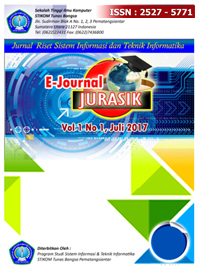Analisis K-Medoids Clustering Dalam Pengelompokkan Data Imunisasi Campak Balita di Indonesia
Abstract
Full Text:
PDFReferences
WHO, “Organisasi Kesehatan Dunia,” www.depkes.go.id (25 Februari 2018), 2015.
Kemenkes RI, Pusat Data dan Informasi Kementerian Kesehatan RI. 2016.
M. G. Sadewo, A. P. Windarto, and S. R. Andani, “Pemanfaatan Algoritma Clustering Dalam Pengelompokkan Jumlah Desa/Kelurahan Yang Memiliki Sarana Kesehatan,” KOMIK(Konferensi Nas. Teknol. Inf. dan Komputer), vol. I, no. 1, 2017.
D. F. Pramesti, M. T. Furqon, and C. Dewi, “Implementasi Metode K-Medoids Clustering Untuk Pengelompokan Data Potensi Kebakaran Hutan / Lahan Berdasarkan Persebaran Titik Panas (Hotspot),” J. Pengemb. Teknol. Inf. dan Ilmu Komput., vol. 1, no. 9, 2017.
S. Defiyanti, M. Jajuli, and N. rohmawati W, “Optimalisasi K - Medoid Dalam Pengklasteran Mahasiswa Pelamar Beasiswa dengan Cubic Clustering Criterion,” TEKNOSI, vol. 3, no. 1, 2017.
E. Setyowati, A. Rusgiyono, and M. A. Mukid, “Analisis Pengelompokan Daerah Menggunakan Metode Non- Hierarchical Partitioning K-Medoids dari Hasil Komoditas Pertanian Tanaman Pangan,” J. GAUSSIAN, vol. 4, no. 4, 2015.
D. Listiyanti, Y. A. Syahbana, and S. R. Henim, “Perancangan dan Implementasi Aplikasi Android Penentu Salient Area pada Video dengan Algoritma K-Medoids,” in ANNUAL RESEARCH SEMINAR 2016, 2016, vol. 2, no. 1.
DOI: http://dx.doi.org/10.30645/senaris.v1i0.75
Refbacks
- There are currently no refbacks.
 








